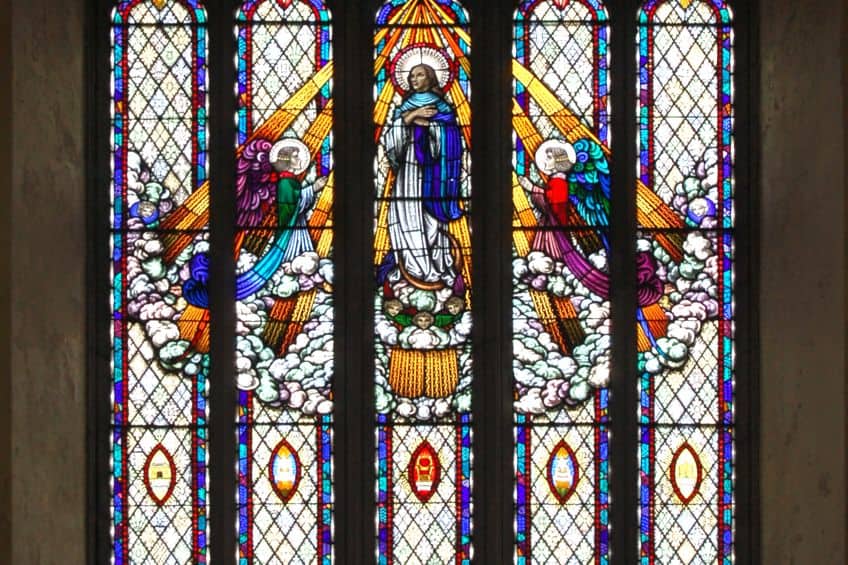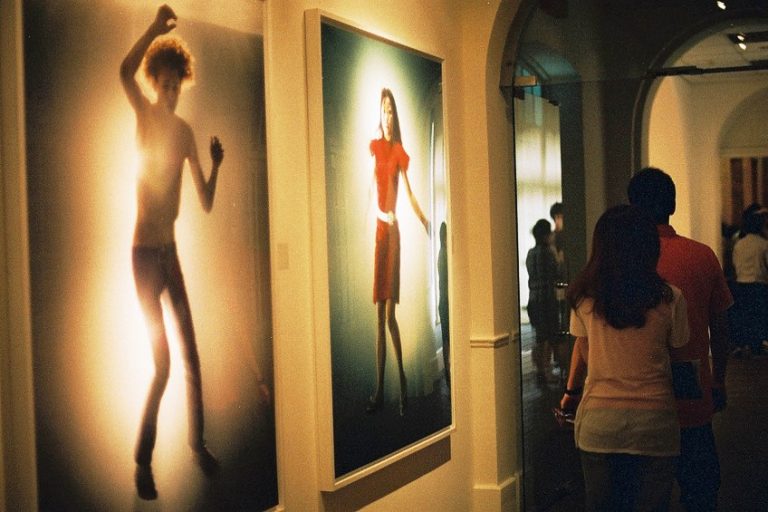Harry Clarke – Illustrations and Stained Glass Windows
Harry Clarke was an Irish stained-glass artist and book illustrator whose work left an indelible mark on the art world of the early 20th century. Born in 1889 in Dublin, Clarke’s intricate and ethereal style captivated audiences with its delicate lines, vibrant colors, and rich symbolism. He gained international acclaim for his mastery of stained glass, creating mesmerizing windows that adorned churches, public buildings, and private homes across Ireland and beyond. Clarke’s illustrations, characterized by their meticulous detail and fantastical imagery, graced the pages of literary classics, showcasing his talent for bringing stories to life through visual storytelling. His legacy continues to inspire artists and art enthusiasts, cementing his place as one of Ireland’s most celebrated artistic figures.
Key Takeaways
- Harry Clarke was a preeminent Irish artist known for his stained glass and illustrations.
- Clarke’s artistry was nurtured in Dublin and was a product of education and European influences.
- His work, particularly in stained glass, is integral to Ireland’s cultural and artistic heritage.
Early Life and Education
| Birth | March 17, 1889 |
| Death | January 6, 1931 |
| Place of Birth | Dublin, Ireland |
| Genre of Work | Stained glass art, illustration, and book design |
Harry Clarke, born in Dublin, emerged as one of Ireland’s most distinguished artists in stained glass and book illustration, deeply influencing the visual arts with his singular style. His education and development as an artist saw him honing his craft at Dublin’s School of Art and later in travels, immersing himself in the innovations sweeping through European art. Clarke mastered the interplay of light and color through his stained-glass works, which often exhibit the intricate detailing and vibrant hues that became his signature.

He is celebrated for his contributions to the Irish Arts and Crafts Movement and for his illustrations that bring to life the haunting tales found in works such as Edgar Allan Poe’s Tales of Mystery and Imagination. Clarke’s body of work, despite his untimely passing at the age of 41, established him as a pivotal figure in Ireland’s visual arts heritage. His legacy endures in the stained glass that adorns spaces of reverence and culture, and his illustrations that continue to captivate the imagination of readers worldwide.
Family Background
Harry Clarke was born on March 17, 1889, in Dublin, Ireland. He was the second son of Joshua Clarke and Brigid MacGonigal. His father, Joshua Clarke, ran a successful decorative arts business which specialized in church decoration and stained glass.
This family environment immersed Clarke in the arts from a young age.
Artistic Training
Educated initially at the Model School and later at Belvedere College, Clarke’s artistic aptitude was evident early on. He then proceeded to study at the Metropolitan School of Art in Dublin, where he honed his skills in stained glass under the tutelage of A.E. Child, a pupil of the renowned British stained-glass artist Christopher Whall. Clarke’s artistic talent was recognized when he received a gold medal in the 1910 Board of Education National Competition.

Initial Works and Recognition
Clarke’s early work consisted mainly of book illustrations and stained-glass designs, which started to gain attention. His precise and intricate detailing along with a blend of Gothic and Art Nouveau elements marked his initial body of work.
Clarke’s unique style quickly earned him recognition within Ireland’s burgeoning Arts and Crafts scene.
Late Period and Death
Towards the later part of his career, Clarke continued to produce significant works in stained glass and illustration. Despite health challenges, he remained dedicated to his craft until his premature death on January 6, 1931. His death was a loss to both Irish and international art communities.

Artistic Accomplishments
Clarke was a leading figure in the Irish Arts and Crafts Movement, and his contributions extended beyond stained glass to include book illustrations. His work was informed by Art Nouveau and Art Deco movements and was particularly influenced by the French Symbolist movement.
Clarke has left a lasting impact on the art world, inspiring generations of artists with his visionary approach and technical skill.
Body of Work
Harry Clarke’s artistic legacy is chiefly defined by his mastery in stained glass design and his influential role as an illustrator, where his work notably embraced themes from fairy tales and literature. His creations continue to resonate, marked by a distinctive style that intertwines the fantastical with the macabre.

Stained Glass Artistry
Clarke’s stained glass pieces display a synthesis of Art Nouveau and Art Deco elements, infused with the narrative quality of the French Symbolist movement. His commission for The Honan Chapel in Cork exemplifies his prowess, blending religious themes with a modern aesthetic.
Significantly, he contributed to various cathedrals and churches, earning him the title of an eminent church decorator.
Illustration Contributions
Harry Clarke gained prominence for his vivid book illustrations, bringing to life the narratives of celebrated authors. His illustrations for Hans Christian Andersen’s Fairy Tales highlighted the whimsy and darkness synonymous with these stories. Clarke’s contribution to the 1919 edition of Edgar Allan Poe’s Tales of Mystery and Imagination, published by Harrap, was met with high acclaim, featuring intricate black and white designs and ethereal color plates. Furthermore, his work on Goethe’s Faust and The Years at the Spring, an anthology that included 24 full-page illustrations, has been praised for its distinctive style and complexity.

Major Projects and Legacy
Harry Clarke’s legacy is cemented by his significant contributions to stained glass artistry and book illustration, which brought Irish cultural identity to an international audience.
His distinctive style, blending elements of Art Nouveau and Art Deco, gave life to fairy tales through glass and ink.
Notable Commissions
- Honan Chapel: One of Clarke’s major works includes the stained glass windows for the Honan Chapel in Cork, which are considered masterpieces of Irish Art Nouveau.
- The Geneva Window: Commissioned for the International Labour Court in Geneva, this window illustrated scenes from Irish literature but was never installed due to its controversial depictions.

International Prominence and Exhibitions
- London and New York: Clarke’s work gained international prominence, with exhibitions in London and New York furthering his reputation.
- Art Nouveau and Art Deco influence: His style was informed by Art Nouveau sensibilities and later by Art Deco, influencing his peers and subsequent generations in both glass artistry and illustration.
Posthumous Recognition
- National Gallery of Ireland: Clarke’s works feature prominently in the National Gallery of Ireland, testament to his enduring significance in Irish culture.
- Harry Clarke Bridge: Dublin honored the artist with the naming of the Harry Clarke Bridge, further embedding his legacy into the city’s landscape.

Legacy of Harry Clarke Today
Clarke remains a seminal figure, inspiring new artists and continuing to enchant audiences with his fairy tale depictions in stained glass and illustrations. The Wolfsonian Museum in Florida houses Clarke’s work, notably The Geneva Window, displaying its intricate details and craftsmanship.
Harry Clarke’s legacy is a testament to the enduring power of art to captivate and inspire across generations. His intricate stained-glass windows and enchanting book illustrations continue to enchant viewers with their beauty and storytelling prowess. Clarke’s contributions to the art world, marked by his unique style and attention to detail, have secured him a lasting place among the pantheon of great artists. As we reflect on his life and work, we are reminded of the transformative impact that creativity can have, leaving an indelible mark on hearts and minds for years to come.
Frequently Asked Questions
What Are the Distinct Characteristics of Harry Clarke’s Stained Glass Work?
Harry Clarke’s stained glass is acclaimed for its intense colors, meticulous attention to detail, and the elegant interplay of light and texture. These works often feature complex, elongated figures and are imbued with a blend of Art Nouveau and Art Deco influences, echoing the aesthetics of the French Symbolist movement.
Which Literary Work Did Harry Clarke Illustrate for the Faust Edition?
For the Faust edition, Harry Clarke provided his illustrative genius in depicting scenes from Johann Wolfgang von Goethe’s tragic play. His illustrations for the 1925 limited edition of Faust beautifully capture the play’s emotional depth and dark themes.
Where Can One Go to See Harry Clarke’s Stained Glass Windows in Ireland?
Harry Clarke’s stained glass windows can be viewed in multiple locations across Ireland, including churches such as St. Patrick’s Cathedral in Dublin and the Honan Chapel in Cork. His work is also prominently featured in the Hugh Lane Municipal Gallery in Dublin.
How Did Harry Clarke Contribute to the Irish Arts and Crafts Movement?
Clarke significantly contributed to the Irish arts and crafts movement through his mastery of stained glass, which revitalized this traditional craft. His work, characterized by a strong personal style and skilled craftsmanship, helped put Irish art on the international radar during the early 20th century.
Isabella studied at the University of Cape Town in South Africa and graduated with a Bachelor of Arts majoring in English Literature & Language and Psychology. Throughout her undergraduate years, she took Art History as an additional subject and absolutely loved it. Building on from her art history knowledge that began in high school, art has always been a particular area of fascination for her. From learning about artworks previously unknown to her, or sharpening her existing understanding of specific works, the ability to continue learning within this interesting sphere excites her greatly.
Her focal points of interest in art history encompass profiling specific artists and art movements, as it is these areas where she is able to really dig deep into the rich narrative of the art world. Additionally, she particularly enjoys exploring the different artistic styles of the 20th century, as well as the important impact that female artists have had on the development of art history.
Learn more about Isabella Meyer and the Art in Context Team.
Cite this Article
Isabella, Meyer, “Harry Clarke – Illustrations and Stained Glass Windows.” Art in Context. May 22, 2024. URL: https://artincontext.org/harry-clarke/
Meyer, I. (2024, 22 May). Harry Clarke – Illustrations and Stained Glass Windows. Art in Context. https://artincontext.org/harry-clarke/
Meyer, Isabella. “Harry Clarke – Illustrations and Stained Glass Windows.” Art in Context, May 22, 2024. https://artincontext.org/harry-clarke/.











